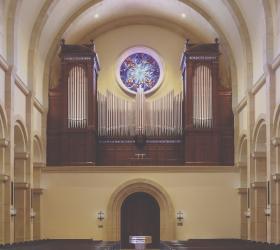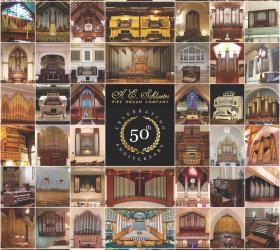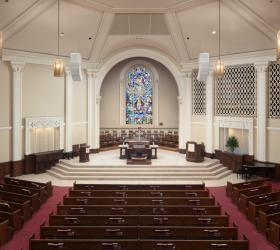
Dobson Pipe Organ Builders,
Opus 90, 2012
The Joseph W. Schreiber Memorial Organ, Independent Presbyterian Church, Birmingham, Alabama
Of the many activities in American churches which I have been privileged to observe, none pleases me more than the Music Program and Religious Arts Festival which has now become so central to the life of Independent Presbyterian Church and the City of Birmingham.
Too often the Arts are regarded as an alternative to the church’s mission. They are part of it. Nourishing people’s imaginations, enlarging their perceptions, facing them with the prophecies which the artists offer to our society, is, I have always held, essential to any kind of evangelism. The association of evangelism with tawdry and trivial art is a deplorable error, against which the authorities of Independent Presbyterian Church are marching with magnificent purposefulness.
— Erik Routley, 1982
Independent Presbyterian Church in Birmingham, Alabama, was founded in 1915 with an initial membership of nearly five hundred people. These first members intended to establish a church dedicated to the glory of God through two primary avenues: the cultivation of beauty, and service to their fellow man. In Birmingham’s early years IPC fulfilled many social-service roles subsequently assumed by public agencies, and the church today maintains ties to those programs as well as administers its own extensive service ministries.
The church’s sanctuary is the work of the Birmingham firm of Warren, Knight and Davis, and was designed by partner William Warren, an IPC member, in the English Perpendicular Gothic style. Completed in 1926, it is built of Shades Mountain sandstone with limestone trim, and has a slate roof surmounted by a copper flèche. The interior is enriched by mosaics that depict the four evangelists and by stained glass windows created by D’Ascenzo Studios in Philadelphia.
Independent Presbyterian Church’s beautiful building is a fitting setting for its extensive fine arts program. With the 1964 arrival of Joseph W. Schreiber as director of music came the establishment of an annual series of organ recitals in November. In the forty-seven years since, programs have been presented by the most celebrated musicians of the day, including E. Power Biggs, Maurice and Marie-Madeleine Duruflé, and Jean Langlais; the 2011 series welcomed Isabelle Demers, Christopher Houlihan, and Jeremy Filsell. The church’s annual Religious Arts Festival, established in 1972 and held in February, presents lectures and programs devoted to the visual and performing arts and their intersection with Christian faith and life.
The choir of Independent Presbyterian Church strives to maintain professional attitudes and high musical standards. The repertoire consists of over seven hundred anthems and fifty major choral works. In addition to its participation in worship, the choir has toured Europe on several occasions since 1977, most recently singing in Prague, Slovakia, and Vienna. It is well represented on recordings, with twelve releases to date.
Along with its many other beautiful appointments, the church was provided with Opus 516 of the Skinner Organ Co., a gift of the church’s Woman’s Organization. Completed with the church in 1926, the organ had three manuals, five divisions, and forty ranks. In 1969, it was greatly altered by the Aeolian-Skinner Organ Co., with many of the original instrument’s distinctive features removed in favor of more contemporary tonal elements. In 1975, preparations that had been made for Antiphonal and unenclosed Positiv divisions were completed by the M.P. Möller Organ Co., bringing the size of the organ to eighty ranks. In 1992, following a fire that destroyed adjacent wings of the church, the instrument was again rebuilt, increasing its size to eighty-seven ranks. However, dissatisfaction with the organ’s compromised tonal design and its increasing mechanical trouble persuaded IPC to explore the possibilities offered by an entirely new pipe organ. A design contract was signed with Dobson in March 2006, and a contract for the construction of the organ was executed in May 2010. With thanks to God for the gifts shared through His servant, IPC has named the instrument the “Joseph W. Schreiber Memorial Organ.”
In preparation for the new pipe organ, Independent Presbyterian Church engaged Robert Mahoney to assess the acoustics of the sanctuary. His analysis identified the ceiling, covered with Celotex, a construction material made of bagasse (sugar cane fiber), as a major absorber of sound energy. In addition to its undesirable acoustical influence, the Celotex was beginning to decompose, so with Mahoney’s help, architect and IPC member Andrew Hicks, of the Birmingham firm of ArchitectureWorks, developed plans for replacement of the ceiling with more reflective materials. This work was carried out by general contractor Brasfield & Gorrie with site supervision by Robert McElroy, and was completed in Summer 2011.
Opus 90 is shaped by two important factors: it is entirely situated in chambers, and it must serve as a capable vehicle for both the accompaniment of a large body of choral works and the interpretation of a broad spectrum of solo literature. Fortunately, at IPC, these factors are complementary. Organ chambers are a relatively recent phenomenon in organ history, and they suggest a style of instrument that developed to exploit strengths of chambers and overcome their weaknesses. The construction of this sort of instrument, in the first half of the 20th century, coincides with the composition of a body of choral repertoire, especially works from England, valued by IPC.
The performance of several centuries’ worth of solo literature stretches the abilities of any instrument. Most works older than the 20th century were conceived on instruments that spoke freely and distinctly, even intimately, into the room. How can an enchambered instrument such as Opus 90 accommodate this music?
Skinner Opus 516 was situated relatively far behind façades of non-speaking pipes. Although there was sentiment within the congregation to retain these façades, we argued strongly for the construction of new casework. Not only would it be able to carry speaking pipes, but the woodwork could also be designed to project farther out of the chambers, allowing the placement of windchests in the chamber openings rather than behind them. This materially aids not only the projection of sound from the Great, whose windchests are immediately behind the façade but also that of the Swell and Pedal, also located in the right chamber, since they can be planted closer to the chamber opening. The new façades were carefully designed to respect the original oak woodwork, and contain pipes of 93% tin belonging to the Great Principal 16′ on the right and the Pedal Octave 16′ on the left.
The Choir and Solo, located in the left chamber, have an interesting relationship dictated by the architectural realities of the chamber. While there was ample room for the pipes of these divisions in that space, the size of the left chamber relative to its opening precluded each division from having a dedicated swell shade front there. Instead, the Solo swell box stands as a separate entity within the Choir, the latter having a shade front in the chamber opening. As a result, the Solo is under double expression.
The arrangement of space in the choir loft similarly affected the design of the console. IPC was eager to introduce a third row of choral seating, but the size of the old console prohibited it. Our new console, inspired by Skinner’s examples, is made as shallow as possible while remaining consistent with the style by, among other things, the provision of only three manuals, with both the Choir and Solo at home on the lowest keyboard.
Tonally, the instrument has a classical structure that is expanded by a variety of 19th- and 20th-century elements. The Great, Swell, and Choir each have choruses framed around 8′ Principals, crowned with appropriate mixtures. The Choir’s second mixture was inspired by the Glockenspiel II in Aeolian-Skinner Opus 1498, in Laurel, Mississippi; containing a tierce, it logically extends the Choir Mixture and provides colorful effects with other registrations. There are manual doubles and trumpet voices of varying tone in every department. Each manual has a cornet or jeu de tierce possibility, and there is a variety of strings of differing scales, including a pair of very slender tin Violes d’Orchestre in the Solo. This division recalls smaller examples of Ernest Skinner, with the unexpected luxury of a 16′ Trombone, originally Opus 516’s Swell Posaune. Because of insufficient height even for pipes of Haskell construction, the Pedal Contra Diapason borrows another page from Mr. Skinner, employing stopped wood pipes of very large scale for the 32′ octave, which then change to open wood pipes for the remainder of the rank. Except for the Solo, wind pressures are moderate, with the Great, Choir, and Pedal upperwork voiced on 4″ pressure, while the Swell is voiced on 51⁄2″. The Solo is voiced on 10″, save for the Tubas, which are on 20″. The Pedal Contre Bombarde 32′ is voiced on 12″. The Great, Swell, and Choir speak on slider windchests having our special design that incorporates relief magnets for crisp repetition with natural speech. To accommodate the higher pressures and provide the volume of wind required, the Solo and Pedal basses have electro-pneumatic windchests.
To honor the original instrument, and because they could contribute to the musical whole, several ranks were retained from Opus 516. Additionally, the Möller Antiphonal organ, with its own petite console in the gallery, has been retained, as well as the Chimes, two digital stops, and the Bell Star.
The voicing of the instrument brings together various tonal influences in a harmonious, well-digested way. Chorus ranks are voiced boldly to fill the nave, while the location in chambers and effective swell boxes give the softer foundation stops subtlety of expression. A modest number of extensions and duplexing expands registrational possibilities without compromising divisional integrity.
IPC welcomed the arrival of the new organ on Wednesday, October 12, 2011, with a ‘Blessing of the Pipes’, a brief service complete with crucifer, thurifer, and bagpiper. The physical installation of the organ was complete by Thanksgiving, and tonal finishing began on January 9, 2012. The dedication of Opus 90 took place in festival services on May 6, 2012, which included two commissioned works, an anthem by Howard Keever and a Tuba Tune by David Briggs. The celebration continued with a concert by Jeff McLelland and the Ambassador Brass on May 13, a recital by Ken Cowan on May 20, and on May 27, a concert featuring the IPC Choir, alumni members of Schreiber’s choirs, and members of the Alabama Symphony in a performance of Brahms’s A German Requiem. IPC’s November Organ Recital Series, now in its 48th year, will present programs by Vincent Dubois (November 4, 2012), Nathan Laube (November 11), Peter Dubois (November 18), and Peter Sykes (November 25). All programs are free and open to the public.
In this day, when budget cuts and the rush to find the lowest common denominator have, if anything, increased the general debasement of liturgical art lamented by Dr. Routley, it has been a true and refreshing joy for Independent Presbyterian Church and Dobson Pipe Organ Builders to work together in the creation of an instrument fit to assist in the worship of God. May it long serve as a prophetic voice of art and inspiration!
—Dr. Jeff R. McLelland
Director of Music and Fine Arts, Independent Presbyterian Church
—John A. Panning, Tonal Director, Dobson Pipe Organ Builders
Dobson Pipe Organ Builders
William Ayers
Abraham Batten
Kent Brown
Lynn A. Dobson
Randy Hausman
Dean Heim
Donny Hobbs
Pat Lowry
Arthur Middleton
John Ourensma
John A. Panning
Kirk P. Russell
Robert Savage
Jim Streufert
John Streufert
Jon H. Thieszen
Pat Thieszen
Sally J. Winter
Randall Wolff
Dean C. Zenor
Dobson Pipe Organ Builders, Opus 90
Independent Presbyterian Church,
Birmingham, Alabama
GREAT (II)
16′ Principal (partly in façade) 61 pipes
8′ Open Diapason 61 pipes
8′ Principal (ext Princ 16′) 12 pipes
8′ Harmonic Flute 61 pipes
8′ Chimney Flute 61 pipes
8′ Gamba 61 pipes
4′ Octave 61 pipes
4′ Spire Flute 61 pipes
22⁄3′ Twelfth 61 pipes
2′ Fifteenth 61 pipes
III Cornet 22⁄3′ 111 pipes
(mounted, g20–g56)
IV Mixture 11⁄3′ 244 pipes
16′ Posaune 61 pipes
8′ Trompette 61 pipes
8′ Posaune (ext Posaune 16′) 12 pipes
4′ Clairon 61 pipes
Tremolo
8′ Tuba (Solo)
8′ Major Trumpet (Solo)
Swell to Great 16′
Swell to Great 8′
Swell to Great 4′
Choir to Great 16′
Choir to Great 8′
Choir to Great 4′
Solo to Great 16′
Solo to Great 8′
Solo to Great 4′
Pedal to Great 8′
Antiphonal to Great 8′
SWELL (III, enclosed)
16′ Bourdon 61 pipes*
8′ Diapason 61 pipes
8′ Bourdon 61 pipes*
8′ Viole 61 pipes
8′ Viole Celeste CC 61 pipes
8′ Flauto Dolce 61 pipes*
8′ Flute Celeste TC 49 pipes*
4′ Octave 61 pipes
4′ Harmonic Flute 61 pipes
22⁄3′ Quinte 61 pipes
2′ Doublette 61 pipes
13⁄5′ Tierce 61 pipes
IV Plein jeu 2′ 244 pipes
16′ Basson 61 pipes
8′ Trompette 61 pipes
8′ Hautbois 61 pipes
8′ Voix Humaine 61 pipes*
4′ Clairon 61 pipes
Swell 16′
Swell 4′
Swell Unison Off
Tremolo
8′ Tuba (Solo)
8′ Major Trumpet (Solo)
Solo to Swell 16′
Solo to Swell 8′
Solo to Swell 4′
Antiphonal to Swell 8′
CHOIR (I, enclosed)
16′ Gemshorn (ext) 12 pipes*
8′ Principal 61 pipes
8′ Salicional 61 pipes
8′ Gedeckt 61 pipes
8′ Gemshorn 61 pipes*
8′ Unda Maris (FF) 56 pipes
4′ Octave 61 pipes
4′ Chimney Flute 61 pipes
22⁄3′ Nazard 61 pipes
2′ Super Octave 61 pipes
2′ Recorder 61 pipes
13⁄5′ Tierce 61 pipes
11⁄3′ Larigot 61 pipes
1′ Piccolo 61 pipes
IV Mixture 1′ 244 pipes
II Sharp Mixture 2⁄5′ 122 pipes
16′ Corno di Basso (ext) 12 pipes
8′ Trumpet 61 pipes*
8′ Corno d’Amore 61 pipes*
Choir 16′
Choir 4′
Choir Unison Off
Tremolo
Swell to Choir 16′
Swell to Choir 8′
Swell to Choir 4′
Antiphonal to Choir 8′
SOLO (I, separately enclosed within Choir)
8′ Viole d’Orchestre 73 pipes
8′ Viole Celeste 61 pipes
4′ Orchestral Flute 73 pipes
8′ French Horn 61 pipes*
8′ Clarinet 61 pipes*
Tremolo
16′ Trombone 61 pipes*
8′ Tuba Mirabilis 73 pipes
8′ Tuba (ext 16′ Trombone) 12 pipes
4′ Tuba Clarion (ext 16′ Tbn) 12 pipes
16′ Major Trumpet TC (ext)*
8′ Major Trumpet 61 pipes*
located in Antiphonal
Chimes 25 tubes*
Harp (digital)*
Solo 16′
Solo 4′
Solo Unison Off
ANTIPHONAL
8′ Spitzprincipal 61 pipes*
4′ Prestant 61 pipes*
2′ Super Octave 61 pipes*
IV Plein Jeu 244 pipes*
PEDAL
32′ Contra Diapason 32 pipes
32′ Contra Bourdon (digital)*
16′ Open Diapason (ext 32′) 12 pipes
16′ Octave (partly in façade) 32 pipes
16′ Principal (Great)
16′ Spitzprincipal (ext Ant 8′) 12 pipes*
16′ Subbass 32 pipes
16′ Gemshorn (Choir)
16′ Bourdon (Swell)
8′ Octave (ext Octave 16′) 12 pipes
8′ Bass Flute (ext Contra Diap 32′)
12 pipes
8′ Bourdon (ext Subbass) 12 pipes
8′ Gemshorn (Choir)
8′ Gedeckt (ext Sw Bourdon 16′)
4′ Super Octave 32 pipes
4′ Flute (Solo)
IV Mixture 22⁄3′ (prepared)
32′ Contre Bombarde 32 pipes
32′ Grand Harmonics (various)
16′ Bombarde (ext 32′) 12 pipes
16′ Posaune (Great)
16′ Trombone (Solo)
8′ Trumpet 32 pipes
8′ Posaune (Great)
4′ Clarion (ext Ped Trumpet 8′) 12 pipes
4′ Clarinet (Solo)
8′ Tuba (Solo)
8′ Major Trumpet (Solo)
Chimes (Solo)
Great to Pedal 8′
Swell to Pedal 8′
Swell to Pedal 4′
Choir to Pedal 8′
Choir to Pedal 4′
Solo to Pedal 8′
Solo to Pedal 4′
Antiphonal to Pedal 8′
Accessories
Bell Star* (located in Choir)
All Swells to Swell
Pedal Divide
Great/Choir Manual Transfer
Transposer
* = Retained from the previous instrument.
Mixture Compositions
Great Cornet III
20–56 22⁄3 2 13⁄5
Great Mixture IV
1–14 11⁄3 1 2⁄3 1⁄2
15–26 2 11⁄3 1 2⁄3
27–38 22⁄3 2 11⁄3 1
39–50 4 22⁄3 2 11⁄3
51–61 8 4 22⁄3 2
Swell Plein Jeu IV
1–12 2 11⁄3 1
13–24 22⁄3 2 11⁄3 1
25–42 4 22⁄3 2 11⁄3
43–61 8 4 22⁄3 2
Choir Mixture IV
1–10 1 2⁄3 1⁄2 1⁄3
11–20 11⁄3 1 2⁄3 1⁄2
21–30 2 11⁄3 1 2⁄3
31–40 22⁄3 2 11⁄3 1
41–50 4 22⁄3 2 11⁄3
51–61 8 4 22⁄3 2
Choir Sharp Mixture II
1–18 2⁄5 1⁄4
19–24 2⁄5 1⁄3
25–30 1⁄2 2⁄5
31–36 4⁄5 1⁄2
37–42 4⁄5 2⁄3
43–45 1 4⁄5
46–49 13⁄5 1
50–54 13⁄5 11⁄3
55–57 2 13⁄5
58–61 22⁄3 2
Pedal Mixture IV
1–32 22⁄3 2 11⁄3 1
Three manuals
82 ranks
97 stops
4,931 pipes
Cover photo: Lynn Dobson




